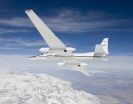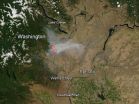(Press-News.org) Every full moon, Landsat 8 turns its back on Earth. As the satellite's orbit takes it to the nighttime side of the planet, Landsat 8 pivots to point at the moon. It scans the distant lunar surface multiple times, then flips back around to continue its task of collecting land-cover information of the sunny side of Earth below.
These monthly lunar scans are key to ensuring the land-imaging instrument aboard Landsat 8 is detecting light consistently. For this, engineers need a consistent source of light to measure. And while there are some spots on Earth – like the Sahara Desert or other arid sites – that reflect a relatively stable amount of light, nothing on our planet beats the moon, which lacks an atmosphere and has an unchanging surface, barring the odd meteorite.
We really wanted something we could trust for Landsat 8," said Brian Markham, leader of the calibration team for Landsat 8, which was built and launched by NASA and is now operated by the U.S. Geological Survey. "We do have Earth sites we look at for calibration. But the precision with which you can track things by using the Earth, because of the atmosphere, is not as good as the moon."
Landsat 8's Operational Land Imager, or OLI, collects information on the visible, near infrared and shortwave-infrared light reflecting off Earth's surface. Each wavelength of light provides information about the ground surface below. OLI has 14 detector modules, each of which contains hundreds of individual detectors that record different spectral bands. The calibration team at Goddard and the U.S. Geological Survey's EROS facility in South Dakota is tasked with making sure each of those detectors register light consistently over time.
Aboard the spacecraft, lamps provide light to calibrate OLl's detectors, but the lamps aren't perfect. On the Landsat 7 satellite, the lamps started to fade before the detectors did. Another option, solar diffusers, which use indirect sunlight, can darken as well.
"Everything else we've tried to use to monitor the stability of our instruments has often not been as good as the instruments themselves," Markham said. But the moon is a steady, not-too-bright light in the sky. "As long as we know what its illumination conditions are, we can trend our instrument performance to it because we trust its stability."
So Landsat 8 planners designed this latest satellite to image the moon as a baseline calibration. If, during these lunar tests, the OLI detectors indicate that the moon is getting slightly duller or brighter, then the Goddard scientists will know the instrument –not the moon – is off. With that data, they can adjust the algorithms that calculate land cover information during Landsat's regular Earth-observation orbits.
It's a fairly complicated operation to scan the moon each month, said Susan Good, a flight dynamics engineer at Goddard who works with Landsat 8.
"There are 14 detector modules," Good said, "each of these has to scan the same path along the moon, so that you collect exactly the same data on each sensor."
The flight dynamics software determines precisely where the spacecraft will need to point during a lunar calibration. The timing is set for just after the moon is completely full. Then, as Landsat 8 passes over Antarctica and heads north in Earth's shadow, the spacecraft maneuvers to the precise location to start the first scan across the lunar surface.
It executes tiny and precise scans to take seven or eight passes across the moon – each one angled so that a different detector is centered on the moon. This takes about 18 minutes, by which time the spacecraft has almost reached the Arctic. So it maneuvers back to point at Earth, and complete its day-lit imaging. Then, Landsat 8 pivots to face the moon again, completing additional passes to test the remaining detectors. After two orbits, the lunar calibration is complete.
In Landsat 8's first year, the lunar calibration tests show that the detectors are stable, Markham said, within a fraction of a percent. If the lunar calibrations and other tests show the detectors are off, the scientists can adjust the calculations that turn the raw Landsat data into information on land cover brightness, maintaining their accuracy.
Since the regular checks on Landsat 8's performance, Good jokes that she will never look at the full moon the same. "I think oh, we're having a lunar calibration," she said. "I always know what Landsat' 8's doing when the moon is full."
YouTube link: https://www.youtube.com/watch?v=F7QKD1c_8BE
INFORMATION:
Landsat looks to the moon
2014-07-11
ELSE PRESS RELEASES FROM THIS DATE:
NASA's high-flying laser altimeter to check out summer sea ice and more
2014-07-11
Sea ice in summer looks dramatically different than sea ice in winter, even in the polar Arctic. Summer snowmelt, pools of water on thinning ice and exposed ocean replace vast winter expanses of white snow-covered ice – and this weekend NASA's high-flying laser altimeter begins a campaign to investigate these features.
Icy areas look different from a satellite's perspective as well. When NASA launches the Ice, Cloud and land Elevation Satellite-2, or ICESat-2, in 2017, it will measure Earth's elevation by sending out pulses of green laser light and timing how long it ...
Out of an hours-long explosion, a stand-in for the first stars
2014-07-11
Astronomers analyzing a long-lasting blast of high-energy light observed in 2013 report finding features strikingly similar to those expected from an explosion from the universe's earliest stars. If this interpretation is correct, the outburst validates ideas about a recently identified class of gamma-ray burst and serves as a stand-in for what future observatories may see as the last acts of the first stars.
"One of the great challenges of modern astrophysics has been the quest to identify the first generation of stars to form in the universe, which we refer to as Population ...
AgriLife Research study identifies contributing factors to groundwater table declines
2014-07-11
VERNON – It's no secret groundwater levels have declined across the state over the past eight decades, and that the primary reason was the onset of irrigation in agriculture and population growth. But a recent Texas A&M AgriLife Research study has identified other factors having an impact.
The groundwater declines have been most severe in the past four decades, but the news isn't all bad, according to Dr. Srinivasulu Ale, AgriLife Research geospatial hydrology assistant professor in Vernon.
"Long-term (1930�) trends in groundwater levels in Texas: Influences ...
USC Stem Cell scientists lay a TRAP for disease
2014-07-11
USC Stem Cell scientists have set a "mouse TRAP" to capture the early signs of kidney failure, as described by a recent study published in the Journal of Clinical Investigation. Their new transgenic mouse line uses a technique called TRAP to extract cellular and genetic information from a variety of solid organs.
Invented by scientists at the Rockefeller Institute for Medical Research in 2008, TRAP involves attaching a fluorescent tag to the protein-making machinery, or ribosomes, of the cell type of interest. Scientists can then collect the tagged ribosomes and determine ...
Major study documents nutritional and food safety benefits of organic farming
2014-07-11
PULLMAN, Wash.—The largest study of its kind has found that organic foods and crops have a suite of advantages over their conventional counterparts, including more antioxidants and fewer, less frequent pesticide residues.
The study looked at an unprecedented 343 peer-reviewed publications comparing the nutritional quality and safety of organic and conventional plant-based foods, including fruits, vegetables, and grains. The study team applied sophisticated meta-analysis techniques to quantify differences between organic and non-organic foods.
"Science marches on," said ...
NMR under pressure: Reproducing deep-Earth chemistry
2014-07-11
VIDEO:
Chemists want to understand chemical reactions that happen in solutions under high pressure in the Earth's crust. A new device invented at UC Davis allows chemists to make nuclear magnetic...
Click here for more information.
A new pressure cell invented by UC Davis researchers makes it possible to simulate chemical reactions deep in the Earth's crust. The cell allows researchers to perform nuclear magnetic resonance (NMR) measurements on as little as 10 microliters ...
Miriam Hospital study examines smoking prevalence
2014-07-11
PROVIDENCE, R.I. -- Researchers from The Miriam Hospital have found that people with mobility impairments under age 65 have significantly higher rates of smoking than those without mobility impairments. Additionally, smokers with mobility impairments were less likely to attempt quitting than those without mobility impairments, and evidence-based, quit-smoking treatments may not be sufficient for this population. The study and its findings are published online in advance of print in the American Journal of Public Health.
Lead researcher Belinda Borrelli, Ph.D., of The ...
Obese US firefighters report receiving no weight advice from their health provider
2014-07-11
HOUSTON – (July 10, 2014) – Obese and overweight firefighters are not receiving weight management advice from their health care providers, according to new research from The University of Texas Health Science Center at Houston (UTHealth).
National guidelines state that health care professionals (HCPs) should advise patients on the importance of maintaining a healthy weight. Firefighters have high rates of obesity, and cardiovascular events are the leading cause of line-of-duty deaths in firefighters. This study assessed the association of age and body mass index (BMI) ...
Many fires in New South Wales, Australia
2014-07-11
There were many fires burning in eastern New South Wales, Australia when NASA's Aqua satellite passed overhead on July 11.
At 03:35 UTC on July 11 (12:35 p.m. local time/11:35 p.m. EDT on July 10), when Aqua passed over eastern New South Wales (NSW), the Moderate Resolution Imaging Spectroradiometer (MODIS) aboard captured a natural-color visible image of the region and spotted smoke (light brown) from various fires. Actively burning areas, detected by MODIS's thermal bands, are outlined in red.
The New South Wales, Australia Government website "NSW Rural Fire Service" ...
Mills Canyon fire, Washington
2014-07-11
The Mills Canyon fire started near the City of Entiat on Tuesday, July 8, 2014. Despite the efforts of local resources, the fire quickly grew to over 1,000 acres by evening. Three outbuildings were damaged. The cause of the fire is under investigation by the Washington Department of Natural Resources. The fire team is working with existing local resources in developing fire control strategies and tactics. Other cooperators include the U.S. Forest Service (USFS), Washington State Department of Natural Resources, (WA DNR), Bureau of Land Management, Chelan County Emergency ...






